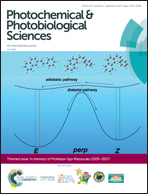A calix[4]arene-based ternary supramolecular nanoassembly with improved fluoroquinolone photostability and enhanced NO photorelease†
Abstract
Micellar-like nanoassemblies of a sulfonate amphiphilic calix[4]arene (1) are able to effectively co-entrap the fluoroquinolone antibacterial norfloxacin (2) and a hydrophobic nitric oxide (NO) photodonor (3), leading to a ternary supramolecular complex having a diameter of ca. 150 nm and a zeta potential of −48 mV. Outstanding photochemical stabilization of the otherwise photolabile fluoroquinolone 2 is observed under UVA excitation. Besides, visible light excitation leads to a remarkable enhancement of the NO photorelease efficiency of 3. Both the results can be explained on the basis of a “cage effect” of the micellar host that, in the case of 2, hinders the formation of the precursor complex responsible for the photodegradation, whereas in the case of 3 it provides a low polarity environment and easily abstractable hydrogens, which facilitate the radical-mediated mechanism involved in NO photorelease. Therefore, this supramolecular ternary nanoassembly simultaneously overcomes the main limitations of the free individual guests such as photolability and low photoreactivity. In view of the well-known antibacterial properties of the NO radical and the biocompatibility of the calixarene host, this nanoassembly represents a suitable bimodal system to be tested in antibacterial research.
![Graphical abstract: A calix[4]arene-based ternary supramolecular nanoassembly with improved fluoroquinolone photostability and enhanced NO photorelease](/en/Image/Get?imageInfo.ImageType=GA&imageInfo.ImageIdentifier.ManuscriptID=C9PP00011A&imageInfo.ImageIdentifier.Year=2019)
- This article is part of the themed collection: In memory of Professor Ugo Mazzucato (1929–2017)


 Please wait while we load your content...
Please wait while we load your content...